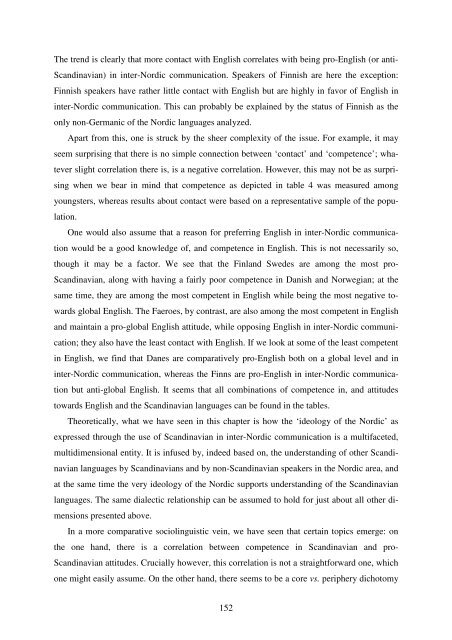Hør dog hvad de siger - Note-to-Self: Trials & Errors
Hør dog hvad de siger - Note-to-Self: Trials & Errors
Hør dog hvad de siger - Note-to-Self: Trials & Errors
Create successful ePaper yourself
Turn your PDF publications into a flip-book with our unique Google optimized e-Paper software.
The trend is clearly that more contact with English correlates with being pro-English (or anti-<br />
Scandinavian) in inter-Nordic communication. Speakers of Finnish are here the exception:<br />
Finnish speakers have rather little contact with English but are highly in favor of English in<br />
inter-Nordic communication. This can probably be explained by the status of Finnish as the<br />
only non-Germanic of the Nordic languages analyzed.<br />
Apart from this, one is struck by the sheer complexity of the issue. For example, it may<br />
seem surprising that there is no simple connection between ‘contact’ and ‘competence’; wha-<br />
tever slight correlation there is, is a negative correlation. However, this may not be as surpri-<br />
sing when we bear in mind that competence as <strong>de</strong>picted in table 4 was measured among<br />
youngsters, whereas results about contact were based on a representative sample of the popu-<br />
lation.<br />
One would also assume that a reason for preferring English in inter-Nordic communica-<br />
tion would be a good knowledge of, and competence in English. This is not necessarily so,<br />
though it may be a fac<strong>to</strong>r. We see that the Finland Swe<strong>de</strong>s are among the most pro-<br />
Scandinavian, along with having a fairly poor competence in Danish and Norwegian; at the<br />
same time, they are among the most competent in English while being the most negative <strong>to</strong>-<br />
wards global English. The Faeroes, by contrast, are also among the most competent in English<br />
and maintain a pro-global English attitu<strong>de</strong>, while opposing English in inter-Nordic communi-<br />
cation; they also have the least contact with English. If we look at some of the least competent<br />
in English, we find that Danes are comparatively pro-English both on a global level and in<br />
inter-Nordic communication, whereas the Finns are pro-English in inter-Nordic communica-<br />
tion but anti-global English. It seems that all combinations of competence in, and attitu<strong>de</strong>s<br />
<strong>to</strong>wards English and the Scandinavian languages can be found in the tables.<br />
Theoretically, what we have seen in this chapter is how the ‘i<strong>de</strong>ology of the Nordic’ as<br />
expressed through the use of Scandinavian in inter-Nordic communication is a multifaceted,<br />
multidimensional entity. It is infused by, in<strong>de</strong>ed based on, the un<strong>de</strong>rstanding of other Scandi-<br />
navian languages by Scandinavians and by non-Scandinavian speakers in the Nordic area, and<br />
at the same time the very i<strong>de</strong>ology of the Nordic supports un<strong>de</strong>rstanding of the Scandinavian<br />
languages. The same dialectic relationship can be assumed <strong>to</strong> hold for just about all other di-<br />
mensions presented above.<br />
In a more comparative sociolinguistic vein, we have seen that certain <strong>to</strong>pics emerge: on<br />
the one hand, there is a correlation between competence in Scandinavian and pro-<br />
Scandinavian attitu<strong>de</strong>s. Crucially however, this correlation is not a straightforward one, which<br />
one might easily assume. On the other hand, there seems <strong>to</strong> be a core vs. periphery dicho<strong>to</strong>my<br />
152



